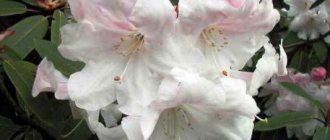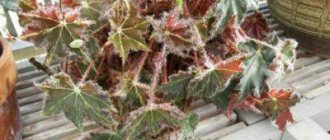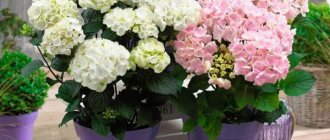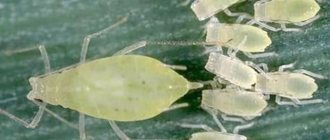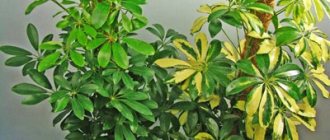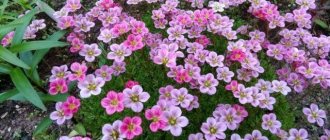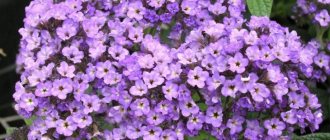Today, there are a huge number of different ornamental crops that have become widespread in modern landscape design. Particularly popular is rhododendron or rosewood, as many gardeners call it. This ornamental plant simply amazes with its bright appearance and lush flowering. There is an opinion that this exotic shrub cannot be grown in the climate of the Urals, but this is absolutely not true. Today, a huge number of fairly cold-resistant and frost-resistant species and varieties of rhododendron have been created, which, with proper care and compliance with all planting rules, you can grow in the Urals.
In this article we will take a closer look at the features of rhododendron, and also note the types and varieties of this crop that can be grown in the Urals. We will also talk about the most important nuances of agricultural technology for growing rhododendron in the Urals.
Frost-resistant varieties of rhododendrons
Peares American Beauty is one of the best frost-resistant varieties. The height of the bush can reach 150 cm. It blooms for a month from May to June. The flowers have a variety of colors: all shades of pink and red with golden patterns on the petals. The variety prefers acidic soil.
Honeysuckle: planting and care in open ground
Barberry: planting and care in open ground, photo
Hibiscus: planting and care in open ground
Queen Bona (Krolowa Bona) is a compact bush no more than 160 cm high. It is distinguished by pale pink flowering. The flowering period is from mid-May to the end of June. Loose and permeable soil is what the variety requires for abundant flowering.
Calsap is a bush no more than 140 cm high. The diameter of the bush is about 130 cm. It is distinguished by white flowers with a slight pink tint. There is a spot on the upper petal that has a lilac-red tint. The variety prefers acidic and loose soils with the addition of humus.
Photo
Below you can see a photo of rhododendron:
Frost-resistant variety Roseum Elegance:
Rhododendron Smirnova:
Variety Grandiflorum:
Rhododendron Japanese:
Rhododendron Lights:
Timing for planting rhododendrons in the Urals
Based on the most beautiful wild species, breeders have created many cultivated varieties. During flowering, such plants are strewn with white, pink, purple, sometimes fragrant corollas. Varietal rhododendrons are most often planted in gardens, but they may not be frost-resistant enough.
There are two favorable periods for planting shrubs in the ground:
- spring, from April to mid-May;
- autumn, from September to October.
The specific period is chosen based on the climatic and weather conditions of the region. The further south you go, the sooner the soil warms up after winter, and the later winter comes. In the northern regions:
- if you plant a seedling early, it will freeze from frost;
- if you delay in the fall, the plant will not have time to acclimatize and will not be able to survive the winter.
In the Urals, Siberia, and the North-West, seedlings that were brought into the garden in the spring and received the most attentive care in the summer take root better. In the south, shrubs are also planted in summer, but only when there are no flowers on them.
Trimming
Rhododendrons are pruned in the spring. The exception is azalea. This plant is pruned after the complete completion of its flowering cycle, as well as after transplantation.
If the azalea has grown greatly and covered the garden paths or windows of the country house, its shoots are cut off to a thickness of 4 cm and the wounds are smeared with garden varnish. Within a year after such pruning, the bush is renewed due to the awakening of dormant buds.
Recent posts Chainsaw or electric saw - what to choose for the garden? 4 mistakes when growing tomatoes in pots that almost all housewives make Secrets of growing seedlings from the Japanese, who are very sensitive to the soil
Shrub pruning is required to renew and awaken dormant buds
Anti-aging pruning is required for old bushes and plants damaged by frost. The oldest shoots are selected from them and shortened to 40 cm. The bushes are rejuvenated in two stages, half a bush every year. With such a rarefied interval, plant renewal occurs less painfully.
Choosing a suitable place for planting rhododendrons in the Urals
For rhododendrons, you need to choose a slightly shaded place; they should not be in direct sunlight for a long time, but strong shade is contraindicated for them, since in this case flowering may not occur.
If possible, it is recommended to plant them under pine trees, near which they grow well. Neighborhood with maples, alder or birch is undesirable, since their superficial root system dries out the soil greatly. If it is not possible to choose another place for planting, then the planting hole must be lined from the inside with covering material. But you should not over-water the plants too much, as rotting of the root system may occur.
Top dressing
The flower is fed twice throughout the year:
- In spring - Add nitrogen-based fertilizers.
- In summer - Immediately after flowering, add superphosphate.
For convenience, you can purchase special fertilizers for this plant at a gardening store, which are used strictly according to the instructions. At the end of summer and autumn, the bush is not fertilized so that it begins to prepare for winter and does not grow new shoots. Every three years, very carefully remove the top layer of soil, trying not to touch the roots. Then a new layer of cow dung mixed with peat is poured on top.
Reproduction of rhododendrons in open ground
The decorative perennial propagates by seed, cuttings, layering and division.
- Cuttings
Growing a new plant from cuttings is quite difficult. This is a time-consuming process and does not guarantee a high result, so any root formation stimulants must be used. Cuttings are made throughout the summer.
The apical buds and all leaves except the top two are removed from the planting material. After soaking in a solution based on a stimulant, the cuttings need to be planted in a light substrate with an acidic reaction.
- Seeds
To grow a bush from seeds at home, you must follow certain rules. At the end of winter or beginning of spring, the seeds are sown in pre-prepared boxes filled with a light and breathable nutrient substrate. After the emergence of seedlings, they are planted in a permanent place.
- Dividing the bush
Adult, three-year or four-year-old bushes with a large number of trunks can be quite easily divided into several parts using a sharp shovel, which must have intact and well-developed roots, as well as several young shoots.
- Vaccination
This option of vegetative propagation is the most effective and allows you to preserve the varietal characteristics of the rootstock and scion. The most common grafting methods are copulation and budding, which are performed using standard technology.
- By layering
The simplest, easiest and most accessible method of propagation for amateur gardeners. Any healthy branch of an adult plant is bent to the soil surface and secured in this position with a wire or a special clamp, after which the middle part is sprinkled with soil. The young seedling is separated in the fall or in the spring, the next year.
Beneficial features
In moderate quantities and as prescribed by a doctor, rhododendron preparations have the following properties:
- bactericidal;
- antipyretic;
- painkillers;
- calming;
- sweatshop.
This once again proves that everything is good in moderation, and even poisons have healing properties. With the help of this plant, you get rid of shortness of breath and swelling, it improves cardiac activity, and lowers blood pressure.
Rhododendron leaves are used in the treatment of rheumatism, epilepsy, colitis and colds, as well as chronic bronchitis and some other diseases. Tea made from the leaves of the plant can reduce headaches and sore throats, as well as relieve coughing with phlegm.
Contraindications to the use of wild rosemary preparations are heart disease, pregnancy, lactation, and renal dysfunction.
Planting rhododendrons in the Urals
Proper planting of rhododendrons is the key to the successful development of the plant in the future. The site should be protected from wind and direct sunlight; in the wild, rhododendrons grow under the cover of trees in the undergrowth. The shade should be sparse; with full shade the shrub does not bloom. A site on the north side of the house, where the sun is present only part of the daylight hours, is well suited for rhododendron. It is good to plant near a pond - the plant loves moist air. Despite its love for moisture, rhododendron does not tolerate its excess at all, so areas with close groundwater are not suitable for the plant, and when constructing a planting hole, drainage must be provided.
Rhododendrons in the Urals care and planting
Floribunda rose varieties with photos and names
Why do onions rot during storage and what to do?
Rhododendron is not suitable for heavy alkaline soil with neutral acidity. Like all heathers, rhododendron prefers acidic soil enriched with peat. The planting hole is filled with the following soil mixture: acidic peat and pine bark with coniferous litter are mixed in half with leaf soil. You cannot add manure and ash - they alkalize the soil.
Description of the plant
A beautifully flowering deciduous, semi-deciduous or evergreen plant is also called a rose tree in the literature due to the noticeable similarity of the inflorescences of most varieties with roses. The shape of the flowers is funnel-shaped, tubular or bell-shaped.
The homeland of the shrub or tree is considered to be East Asia, Japan and North America. The structure of rhododendron differs depending on the species. It can have both small and large leaf plates of an elongated or ovoid shape with smooth or pointed edges. Bisexual flowers form inflorescences in the form of racemes or corymbs. Solitary - rarely seen.
Watering rhododendrons
Rhododendrons are moisture-loving plants, so they need regular and abundant watering. Approximately each plant requires two waterings per week. It is necessary to water rhododendrons more abundantly at the time of active growth and the formation of flower buds. The plant also loves not only soil moisture, but also atmospheric moisture. To do this, shrubs can be sprayed with a hose or spray bottle. It is important to use soft water, taken from a pond or rain. Tap water contains calcium, which accumulates at the roots. Before watering, you can add oxalic acid to the water.
LiveInternetLiveInternet
–Categories
Tomas Kinkade (13) In the animal world (182) Spring (83) VIDEO (507) Baking (1938) ***Pancakes (183) ***Buns, cheesecakes, buns. (140) ***Cupcakes (93) ***Easter and Easter cakes (184) ***Cookies (167) ***Pies. Charlottes. Casseroles. (332) ***Pies (117) ***Rulets (103) ***Bread. (77) Knitting (knitting, crocheting) (992) Ladies' magazine (279) Summer cottage (1055) *Eggplant (6) *Cabbage (8) *Potatoes (2) *Strawberries (12) *Cucumbers (15) *Peppers ( 9) *Tomatoes (30) *Flowers (flower beds) (350) Victory Day (116) For children (255) Homemade preparations (recipes) (475) Friends! (79) Woman (205) Magazine *Health* (333) Screen stars (188) Ringing cedars of Russia (142) Winter (97) Pictures (paintings, illustrations, paintings) (3135) Clipart (640) Transition buttons for LiRu (18 ) Indoor floriculture (39) Cat's world (84) Dolls (194) Cooking (various recipes) (2984) ***Dumplings. Dumplings. Manta rays. Khinkali. (50) ***All chicken (212) ***All fish (222) ***Cooking cheese (various) (14) ***for New Year and Christmas (210) ***Casseroles (58) ***Porridge (miscellaneous) (19) ***Culinary (kitchen) tricks (33) ***Drinks (Kvass. Juices.) (145) ***First courses (170) ***Lenten dishes (203) ***Salads (352) ***Lard (15) ***Sweets (91) ***Sauces (19) Legends, parables, aphorisms. (66) Summer (50) Masks (clipart) (15) World of travel (911) Music (353) Still lifes (315) New Year's page (339) Autumn (132) Postcards (120) Easter (97) Easter recipes (62) Holidays (349) Programs for PC. (309) Bird World (110) PNG Dividers (8) Frames (323) Photo Frames (PNG) (25) Religion (96) Christmas (70) Crafts (332) DIY (or DIY) (197) Scrap set (629) Poetry (162) Dances of the peoples of the world (18) Cakes (cooking) (561) Foreign lessons. (8) FS lessons (151) Comfort in the home (146) Porcelain (antiques) (136) Backgrounds, diagrams for Days
(102) Photos (138) Flowers (162) We sew ourselves (162) Esoterics (59) This is important! (51) This is interesting (867)
Diseases and pests of rhododendrons
Rhododendrons are rarely affected by diseases and pests. But with frequent overwatering or lack of moisture, sunburn, improperly selected soil or insufficient nutrients, they can become infected with rust, spotting or chlorosis. In this case, the affected leaves and other parts should be removed from the plants and then treated with a fungicide.
If snails or slugs appear on the bushes, they will have to be collected manually. Spider mites, mealybugs, weevils and scale insects are destroyed with an insecticide solution. In the future, you need to adjust the conditions for keeping the plants.
Sheltering rhododendrons for the winter in the Urals
The main purpose of the shelter is to protect the rhododendron from strong winds and heavy snow; they are more likely to cause damage than low, stable temperatures. After the arrival of stable cold weather (late October - mid-November), the branches need to be carefully tied. It is better to tie a tall bush to a support. And flexible species (Schlippenbach, some hybrids) are better to tilt for wintering under the snow (at least part of the bush) and imagine how it will lie so as not to break the stems. Drive a high stick near the bush and put a cover made of white burlap, agrofibre or light fabric (sheet, duvet cover) on the bush or cover it with lutrasil (spunbond). Such a shelter will protect the plant from the scorching spring sun, the branches will not get tangled and will easily straighten out in the spring. And thanks to the stick, the snow will roll down and the branches will remain intact. Instead of sticks, you can drive supports into the corners and attach covering material (hut, frame or house) to them, so that if a lot of snow falls in winter (100-140 cm in height), it does not press the branches to the ground. Then in the spring the bush will need more effort to restore the shape of the stems, and flowering will worsen. You can put spruce branches inside.
How to care
The climate in the Urals is more severe, which requires special attention to shelter for the winter. Otherwise, agricultural cultivation techniques are similar across regions. It includes regular fertilizing, moisturizing, and monitoring the phytosanitary condition of the plant crown.
Watering
The moisture-loving rhododendron is watered weekly, monitoring the condition of the soil. It should remain slightly damp and not dry out. The consumption rate for an adult specimen is 1.5 buckets. Use settled water at room temperature.
Top dressing
Fertilizers are applied 4 times during the growing season. Nitrogen-containing fertilizing is carried out in the spring to stimulate shoot growth. During the budding period, phosphorus is used. And in October, potassium complexes are used, which help the plant prepare for the cold and go into winter strong. Every 3 years, the surface layer of soil is renewed: 10 cm of soil is removed and replaced with a substrate of rotted manure, turf soil and peat.
Bush formation
Rhododendron grows slowly and does not require intensive pruning. In the spring, dry and broken shoots are cut out, and the sections are treated with wood ash. To ensure that the shrub blooms luxuriantly every year, the wilted inflorescences are broken off. The procedure promotes the formation of new flower buds.
Shelter for the winter
Even frost-resistant varieties will not withstand the Ural cold without additional shelter. A drop in temperature below -5 °C signals the need to protect the plant. A shelter that will protect rhododendron from winter cold, spring scorching sun and melt water includes the following:
- Mulching the root zone with peat chips.
- Installing a frame of slats or metal rods over the bush.
- Covering the structure with covering material.
With the arrival of spring, the shelter is not immediately removed: there is a high risk of return frosts. But they constantly make sure that it is not too hot under the covering material. Excessively high temperatures and lack of fresh air can lead to overheating of the growing point.
